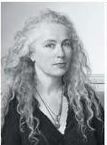Opening Friday night at the Henry Gallery as part of an open house, 6-11, is
I Myself Have Seen It: Photography by Kiki Smith, curated by Elizabeth Brown.
 When Smith spoke Thursday night to a packed house, many who showed up probably thought she’d talk about the exhibit. She touched on it but turned away, saying only that she began using photographs of her work as work when she needed to fill a space and improvised the photos into a kind of serial narrative.
When Smith spoke Thursday night to a packed house, many who showed up probably thought she’d talk about the exhibit. She touched on it but turned away, saying only that she began using photographs of her work as work when she needed to fill a space and improvised the photos into a kind of serial narrative.
Instead, in a voice that’s close to music with her curly gray hair streaming around her, she digressed. Each topic became a stepping stone to different parts of her mental garden.
The University of Washington did not help. Her slides were constantly out of focus and did not improve unless she asked the person in booth to do something. The lights were too bright to see the slides well, and the microphone during the questions period was unreliable. She remained serene. Gently, she said about one slide, “I don’t think you can see it, and it’s upside down.”
Below, in her own words, random quotes from the endlessly quotable Ms. Smith.
I don’t know what I’m going to say. I hope to jar my mind into having a thought. I basically don’t have any necessity to talk in my life.
My greediness, in the end, is to show you something completely
different.
Refuse to be owned by style. Do not be strangled by your own history. Flip the meaning. Explore the facets. What holds up for you at one time doesn’t have to hold up for the rest of your life. Your work can be conflicted. I used to be interested in how much skin a body had, how much blood. I’m not as exact now.
You get to cannibalize your own work to get as much mileage out of it as you
can. While creativity is given to you freely, it’s not given every day.
The feminist moment radically changed what art could be. I looked to Nancy Spero, who worked on paper, made prints and made art out of being a woman; Eva Hesse, who made the body abstract, and Barry Le Va, who is so good at the difference between two dimensions and three dimensions. When I was young, I’d see something by Bruce Nauman and want to throw in
the towel. A few days later, I’d think, there’s still a little space he
isn’t in.
You can’t wait around for other people to want or need you work. There were times that making paperweights kept me afloat financially. I wanted to be an artist whose work would wind up (on sale) at Macy’s.
The only time my father (Tony Smith) touched his sculpture is when a photographer came and asked him to put his hands on it.
Richard Tuttle is our greatest American artist, maybe, according to me.
I hate all this junk they teach in art school, where you’re supposed to
know what you’re doing. It’s only in the unknown that we get to blossom.
Why her colors tends to be muted:
I was around the process sculptors, like Richard Serra and Alan Saret. Color seemed indulgent. That’s my American Puritanism, I think. I could change that.
On collaborations:
I collaborate with people when they do want I want them to do, people who have some
super facility in printmaking or blowing glass. They have something in their bodies I’ll never have in my body.



Sounds like a poem.
Sounds like a good talk.
One of the great things about living in Fort Worth is the art museums, and one of the best things about them is the series of 20-24 talks by artists (mostly, a few curators & critics have shown up from time to time) that the Modern presents every year.
Usually fewer than a quarter of these are related to an exhibition, and the range of people talking has been amazing.
It’s a great community service. More institutions should do series’ like this.
What a beautiful transcript of snippets – some of which I’m in desperate need of hearing. It’s a shame I had to miss the talk, so thank you for writing about it a bit. She’s truly one of my favourites.
On the subject of making the work herself (rather than having it produced in a workshop):
It’s important to me that those marks are mine. I like the fact that by investing my energy in this thing, the energy gets transformed into something that I can look into as a reflection.
(At least she said something very close to that. I didn’t write it down fast enough.)